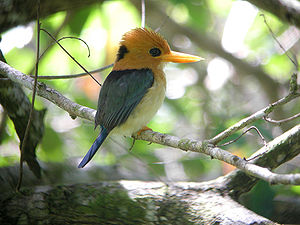Yellowbilliest
| Yellowbilliest | ||||||||||
|---|---|---|---|---|---|---|---|---|---|---|

Yellow-billed beak ( Syma torotoro ), male |
||||||||||
| Systematics | ||||||||||
|
||||||||||
| Scientific name | ||||||||||
| Syma torotoro | ||||||||||
| Lesson , 1827 |

The yellow-billed bird ( Syma torotoro ) is a bird of the kingfisher family found in New Guinea and on the Cape York Peninsula .
description
Appearance
Adult yellow-billed nests reach a length of approx. 20 centimeters. The weight of the males varies between 32 and 50 grams. Females weigh between 30 and 52 grams. There is weak sexual dimorphism between the sexes . In the males, the head and collar are orange-yellow to cinnamon-red. The feathers of the crown are sometimes set up. A black spot stands out on the neck. The chest and belly are cream in color. The wings and back are dark green-blue, the control feathers blue. The females show similar drawing patterns as the males. The main difference between them is the black top of the head. The beak is bright yellow in both sexes, the iris is dark brown, legs and feet are yellowish.
Vocalizations
The vocalizations of the Gelbschnabelliest consist of a series of loud, clear and short trills, performed in descending order, which last one to two seconds. Sometimes trills are played for five to six seconds at a constant pitch and at the end with a reduced volume.
distribution and habitat
The yellow-billed bird is found in New Guinea and the Cape York Peninsula . It prefers to colonize rain and mangrove forests , and sometimes also rubber plantations. The altitude distribution usually reaches up to 500, in exceptional cases up to 1300 meters.
Subspecies
In addition to the nominate form Syma torotoro torotoro , which occurs in New Guinea , two other subspecies are known:
- Syma torotoro ochracea Rothschild & Hartert , 1901, on the D'Entrecasteaux Islands
- Syma torotoro flavirostris ( Gould , 1850), on the Cape York Peninsula
Way of life
The birds feed primarily on insects, little bristles (Oligochaeta) and small reptiles. Observations in New Guinea showed that 73% of food is collected from the ground, 18% from foliage, and 9% from the air. Nests are created and actively defended by both parents at heights between three and 15 meters behind self-dug tunnels in termite mounds on trees , rarely in tree hollows. The clutch consists of one to four eggs. The eggs are white. Further details on breeding behavior have yet to be researched.
Danger
The yellow beak is not uncommon in its distribution areas. It is therefore classified by the World Conservation Organization IUCN as ![]() “ least concern = not endangered”.
“ least concern = not endangered”.
swell
literature
- Josep del Hoyo , Andrew Elliott, Jordi Sargatal : Handbook of the Birds of the World, Mousebirds to Hornbills. Volume 6, Lynx Edicions, 2001, ISBN 978-84-87334-30-6 , p. 226.
Individual evidence
- ↑ a b c d Woodall, PF & Kirwan, GM (2016). Yellow-billed Kingfisher (Syma torotoro). In: del Hoyo, J., Elliott, A., Sargatal, J., Christie, DA & de Juana, E. (eds.). Handbook of the Birds of the World Alive. Lynx Edicions, Barcelona. (retrieved from http://www.hbw.com/node/55778 on August 26, 2016)
- ^ Thane K. Pratt and Bruce M. Beehler: Birds of New Guinea , Princeton University Press, 2015, ISBN 978-0-691-09562-2 , p. 391
- ^ IUCN Red List